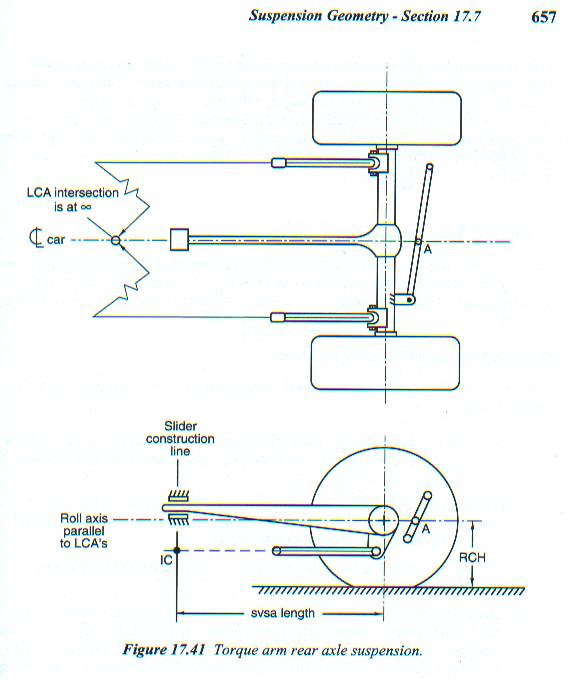The SVIC can be at a "real" TA's front mount, but that would only be by coincidence. That the TA's front mount must in some manner accommodate plunge by the TA means that the IC is normally elsewhere.
Umm, perhaps it's time to ask just what kind of car/rear suspension is involved, just to make certain that we're thinking of the same thing. F-bodies (and I think the various Vega/Monza platform variations) used a true torque arm, but what was termed a TA in the GNX (and in Kirban's early advertising copy for their identical product) is something else. That one is also capable of resisting fore/aft forces (and had better line up pretty closely with the front LCA pivots as seen in side view for anything resembling reasonable street operation). In the GNX arrangement, the SVIC is always at the chassis pivot of the traction bar/single ladder bar component that attaches off a reinforced diff cover, and this may be introducing some confusion.
With a torque arm, what you do know is that the TA's front mount ideally sees only a force that's perpendicular to the TA (assuming either frictionless sliding within a bushing or a double rod-ended vertical link arrangement). That force points to the IC, and you should be looking at the physical length of the TA and the virtual length along that force line as making up an L-shaped arm. You also know that the LCA forces point straight along the LCAs and must also be aimed at the IC. That's what defines the arc through which the axle moves, even though the vertical force can only be applied at the TA bushing. The anti-squat property of this arrangement is mostly a function of the LCA inclination and TA length, with TA inclination having relatively little effect.
A GNX style piece is different. In its OE configuration it is much shorter relative to the wheelbase than the F-body TA is to its. The arc in side view that the axle must follow can be completely defined by it alone. That leaves the LCAs responsible for axle end fore/aft location and (some of) the fore/aft force only. Raising the pivot of the GNX device is going to have a far greater effect on IC position and anti-squat than raising a TA bushing end. If its pivot wanders very far from the LCA pivots the rear suspension will tend to bind up, as the LCAs and the traction arm will start having different ideas about the arc that the axle should be following. One conceivable end result would be for some rear end lift to occur (assuming >100% anti-squat), followed by whatever compliance remains in the suspension bushings to be used up resulting in an increased tendency to lift the front. It's your mention of the sensitivity of the suspension to only 1.5" pivot relocation that has focussed my attention in this direction. If I'm off-base here, just ignore it.
Norm

